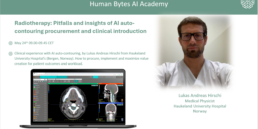Exciting Milestones in Precision Radiotherapy (PRT)
Our precision radiotherapy (PRT) endeavors have achieved remarkable progress, with 16 accepted abstracts at ESTRO this year, surpassing last year’s count of 13. Collaborating with esteemed clinical and academic partners, these insights hold the potential to revolutionize radiotherapy (RT) workflows. Our focus areas include automated treatment planning, vendor-agnostic adaptive radiation therapy, magnetic resonance-only RT planning, and uncertainty-aware automatic delineation of tumors and organs at risk, guided by consensus protocols.
End-to-End Automation for Prostate Cancer Treatment Planning
We’re thrilled to announce significant progress with ART-Plan®, poised to offer comprehensive support soon for end-to-end automated and robust radiotherapy planning. Integrating dose prediction into treatment planning, we address individual patient anatomy and tumor characteristics with precision. These advanced systems efficiently deliver complex treatment parameters, ensuring optimal dose delivery while accounting for uncertainties related to patient positioning and anatomical changes (Unguna,b et al, Delasalles et al.). Dubois et al. tackled another critical aspect of treatment planning, introducing the concept of robustness through a graph-based multi-plan optimization strategy. AI-enabled automation enhances planning robustness, reliability, and patient-specific tailoring, promising improved treatment outcomes and minimized dosing risks.
Adaptive Radiotherapy & Enhancing CBCT Imaging Quality & Magnetic Resonance Workflows
In a groundbreaking development, our work has elevated cone beam CT (CBCT) imaging to diagnostic quality, revolutionizing radiotherapy treatment. Through partnerships like Chalkia et al., we’ve demonstrated the full equivalence of synthetic CBCT for alignment with planning CT in head and neck radiotherapy workflows. Integrated with a full dose calculation framework (Colomboa et al.), ART-Plan® now allows real-time dose monitoring and adaptive replanning, promising unparalleled precision and personalized care across critical areas such as the breast (Colombob et al.), head and neck (Colomboc et al), and thorax (Colombod et al). Leclercq et al. have further highlighted the efficacy of synthetic CT in offline adaptive replanning, validating its transformative potential. Finally, Pantelis et al. explored an MRI-only protocol for synthetic CT generation in intracranial radiosurgery. Their study demonstrated reliable results, confirming clinical acceptability for this workflow. Cafaro et al. delved deeper into the concept of utilizing bi-planar imaging as an alternative method to assess treatment delivery, employing generative artificial intelligence for full volumetric reconstruction.
Elevating Organ and introducing effective Tumor Delineation
Achieving precise organ and target volume delineation is a significant challenge. Perennec et al. improved this by integrating anatomical reasoning into automatic contouring, enhancing guideline alignment. Costea et al. demonstrated the generalizability of AI models across patient populations, while Schmidt-Mengin et al. introduced a novel weakly supervised method enabling successful automatic segmentation. Additionally, Leroy et al.’s diffusion model, trained from histological-defined ground truth and transferred to CT, outperformed consensus in head and neck target volume delineation among expert physicians.
Collectively, these strides mark significant progress toward advancing radiotherapy precision, underscoring our commitment to pioneering innovation and improving patient care.
List of Abstracts
- B. Ungun, G. Güngör, M. Moll, S. Cozzi, V. Gregoire, M-L. Costea, P. Fenoglietto, N. Bus, N. Paragios. Quantitative and qualitative evaluation of an automated planning solution for prostate radiotherapy.
- B. Ungun, R. Vauclin, E. Delasalles, E. Mengin, G. Güngör, M. Costea, F. Gassa, V. Gregoire, P. Maury, C. Robert, P. Fenoglietto, N. Bus, N. Paragios. End-to-end automatic treatment planning for prostate radiotherapy.
- E. Delasalles, R. Vauclin, E. Mengin, B. Ungun. M. Costea, N. Bus, N. Paragios, P. Fenoglietto, G. Gungor, N. Komodakis. Dose Prediction for Prostate Radiotherapy Planning.
- P. Dubois, G. Temiz, R. Marini-Silva, N. Bus, P. Fenoglietto, N. Paragios, PH. Cournede. A Novel Framework for Multi-Objective Optimization and Robust Plan Selection Using Graph Theory.
- M. Chalkia, M. Psarras, G. Patatoukas, T. Stroubinis, D. Stasinou, N. Kollaros, M Protopapa, V. Kouloulias, K. Platoni. The use of synthetic cone beam computed tomography in head and neck image guided volumetrically modulated radiation therapy.
- L.Colombo, A. Oumani, E. Delasalles, M. Uluer, G. Aydin, O. Teboul, N. Paragios, G. Güngör. Evaluation of dose calculations on different CBCT-based synthetic-CTs: a comparative study.
- L. Colombo, A. Oumani, M. Schmidt-Mengin, S. Orache, S. Romdhani, S. Kandiban, B. Romain, G. Temiz, O. Teboul, N. Paragios, P. Fenoglietto. Self-Supervised GAN Based Synthetic CT Generation from Breast CBCT.
- L.Colombo, A. Oumani, M. Schmidt-Mengin, S. Orache, S. Romdhani, S. Kandiban, B. Romain, G. Temiz, O. Teboul, N. Paragios, P. Fenoglietto. Self-Supervised GAN Based Synthetic CT Generation from Head and Neck CBCT.
- L. Colombo, A. Oumani, M. Schmidt-Mengin, S. Orache, S. Romdhani, S. Kandiban, B. Romain, G. Temiz, O. Teboul, N. Paragios, P. Fenoglietto. Self-Supervised GAN Based Synthetic-CT Generation from Thorax CBCT.
- B. Leclercq, B. Romain, M. Costea, L. Colombo, S. Romdhani, N. Bus, O. Teboul, N. Paragios, V. Plagnol. AI powered decision-making process for RT re-planning.
- E. Pantelis, A. Moutsatsos, P. Archontakis, S. Romdhani, A. Stergioula, P. Papagiannis, and N. Paragios. A proof of concept for MR-only workflow in CyberKnife intracranial radiosurgery.
- A. Cafaro, A. Leroy, G. Beldjoudy, P. Maury, A. Munoz, C. Robert, V. Lepetit, N. Paragios, V. Grégoire, E. Deutsch. 3D CT Reconstruction from biplanar projections with integration of planning CT.
- T. Perennec, M. Roge, S. Supiot, S. Romdhani, M. Costea, G. Temiz, O. Teboul, N. Paragios. Guidelines-based automatic segmentation improvements.
- M-L. Costea, L. Colombo, G. Güngör, G. Klausner, JP. Clavier, N. Leduc, C. Robert, C. Herve, E. Özyar, S. Romdhani, O. Teboul, G. Temiz, N. Paragios. Breast cancer annotation across genders.
- M. Schmidt-Mengin, Q. Spinat, A. Benichoux, G. Temiz, L. Colombo, M. Costea, O. Teboul, N. Paragios. A new method for training automatic tumor contouring models without manual annotations.
- A. Leroy, A. Cafaro, N. Benzerdjeb, A. Champagnac, G. Gessain, P. Gorphe, D. Morel, C. Robert, R. Sun, P. Zrounba, V. Lepetit, N. Paragios. Histology to CT transfer for HNC target volume auto-segmentation with deep-learning diffusion models.
Related Posts
25 June 2024
Unlocking the Potential of AI Auto-Contouring in Radiotherapy at HELSE Bergen [WEBINAR]
Clinically Relevant AI in Radiation…
24 October 2023
Innovations in Radiation Oncology: Harnessing AI for better patients outcomes [WEBINAR]
Clinically Relevant AI in Radiation…




